Improving Performance by Measuring Pain
Oleander Poisoning Mishap
Assessing Respiratory Disease in the Field
Technician Update: Treating Anhidrosis With Acupuncture

Vol 12 Issue 4 2023
www.modernequinevet.com
ASK THE INFECTIOUS DISEASE EXPERT Equine
Vet The Modern
SALES: ModernEquineVet@gmail.com
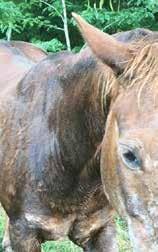
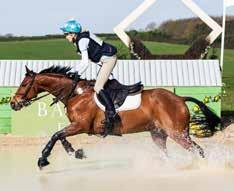
EDITOR: Marie Rosenthal
ART DIRECTOR: Jennifer Barlow
CONTRIBUTING WRITERS: Paul Basilio • Rob Warren

COPY EDITOR: Patty Wall
LEGAL DISCLAIMER: The content in this digital issue is for general informational purposes only. PercyBo Publishing Media LLC makes no representations or warranties of any kind about the completeness, accuracy, timeliness, reliability or suitability of any of the information, including content or advertisements, contained in any of its digital content and expressly disclaims liability of any errors or omissions that may be presented within its content. PercyBo Publishing Media LLC reserves the right to alter or correct any content without any obligations. Furthermore, PercyBo disclaims any and all liability for any direct, indirect, or other damages arising from the use or misuse of the information presented in its digital content. The views expressed in its digital content are those of sources and authors and do not necessarily reflect the opinion or policy of PercyBo. The content is for veterinary professionals. ALL RIGHTS RESERVED. Reproduction in whole or in part without permission is prohibited.
2 Issue 4/2032 | ModernEquineVet.com TABLE OF CONTENTS
Published by PERCY BO media publishing PO Box 935 • Morrisville, PA 19067 Marie Rosenthal and Jennifer Barlow, Publishers Equine Vet The Modern EMERGENCY MEDICINE Oleander Poisoning Mishap 8 RESPIRATORY DISEASE Assessing Respiratory Disease in the Field ................................................... 12 NEWS NOTES Study Reveals Opportunities to Increase Productivity 15 TECHNICIAN UPDATE Treating Anhidrosis with Acupuncture ........................................................ 16 SPONSORED EDITORIAL “What are the latest infectious disease updates from the Equine Respiratory Biosurveillance Program?” ................................................................. 7 Improving Performance
Measuring Pain COVER STORY 4 Cover: Shutterstock/el-ka ADVERTISERS Arenus Animal Health/AssureGuard Gold 3 Merck Sponsored Editorial 7 Arenus Animal Health/Aleira-Releira 9 American Regent/Adequan 11 Merck Animal Health 13
by
THE
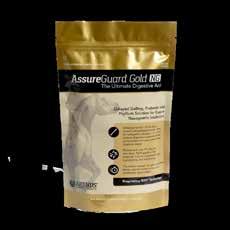


Arenus Animal Health | 866-791-3344 | www.arenus.com SO INNOVATIVE...
Replace your mineral oil, electrolytes, adsorbents, or other treatment options with Assure Guard Gold-NG the only effective and easy to administer slow gelling quick relief formulation including 2 cups of ultra pure psyllium, 72 billion CFU of probiotics, prebiotics, antacids, L-glutamine, electrolytes and energy. For continued support, consider a 10 day supply of Assure Guard Gold after treatment. IT’S LIKE MAGIC Ask your Arenus Veterinary Solution Specialist how Assure Guard Gold-NG and Assure Guard Gold can help your equine patients quickly and effectively recover from the digestive upsets you treat daily.
® Assure Guard
Together, Assure Guard Gold-NG And Assure Guard Gold Create A Powerhouse Against Your Most Challenging Digestive Cases. Use Assure Guard Gold-NG For Fast Relief And Maintain Excellent Digestive Health With Assure Guard Gold.
REAL MAGIC IS IN THE RESULTS
The Ultimate Digestive Aid
Gold
IMPROVING PERFORMANCE
BY MEASURING PAIN
Regular Use of the Ridden Horse Pain Ethogram Could Improve Equine Performance

Using the Ridden Horse Pain Ethogram (RHpE) before an event would enable veterinarians, trainers and riders to identify a painful horse earlier, which could improve equine performance and welfare as well as safety for horse and rider, according to Sue Dyson, VetMB, PhD. It might even protect the future of equine sporting events, she said at the AAEP Annual Convention.
“I believe that use of the RHpE should facilitate earlier identification of horses, which may benefit from diagnosis and targeted treatment and management, potentially resulting in improvement in both performance and equine welfare,” she said.
“By identifying and treating the underlying problems in horses with scores of 7 or more, there is the potential to improve equine welfare, to improve horse and rider safety by reducing falls and also to
enhance the performance of horses.”
The RHpE is a series of 24 behaviors with strict definitions, for example—ears back for at least5 seconds, repeated tail swishing—“the majority of which are at least 10 times more likely to be seen in a lame horse compared with a non-lame horse,” she said. Each of the behaviors could have a variety of causes. It is the total RHpE score which is important.
“A RHpE score of 8 or more signifies the presence of musculoskeletal pain and the reduction in RHpE scores after resolution of lameness by diagnostic anesthesia demonstrates a causal relationship between pain and these behaviors,” Dr. Dyson said.
To support her proposal, she discussed several studies that demonstrated the usefulness of the RHpE. A prospective cohort study in 2018 looked at horses during a 5-star, 3-day event. All 35 horses on
By Marie Rosenthal MS
4 Issue 4/2022 | ModernEquineVet.com Shutterstock/Simon Bratt
SPORTS MEDICINE
the second day of competition were assessed for a minimum of 10 minutes during the warmup phase for dressage in walk, trot and canter, and performing movements such as shoulder in, half pass and canter flying changes. Horses were classified subjectively as either being non-lame, lame or showing a stiff stilted gait in either trot or canter.
The ethogram was applied by a trained assessor and performance results were obtained from the British Eventing website for the cross-country phase of the 3-day event.
“Among horses with a RHpE score of less than 7, 29% were eliminated or retired on the cross-country phase. Whereas of those horses scoring 7 or more out of 24, 67% were eliminated or retired,” she said.
A minimum score of 8/24 is a reliable way to differentiate horses with and without musculoskeletal pain, but a score of 7 might be better for horses competing at an advanced level, Dr. Dyson suggested.
In 2019, they looked at two 5-star, 3-day events with a total of 137 starters. RHpE scores ranged from between 0 to 9 out of 24.
“There were significant differences in the scores of the non-lame horses with a median score of 3 compared with the horses with gait abnormalities in either trot and or canter with a median score of 5,” she said.
“Horses with a RHpE score of 7 or more compared with horses which scored less than 7 during the dressage warmup had higher dressage penalties, were more likely to be eliminated (because of horse or rider falls or refusals) or retire on cross-country, and of those that finished, the horses that scored 7 or more had lower finish places,” Dr. Dyson said.
“When we combined the data from the pilot study and the main study, of the 172 starters, there was a strong significant association between RHpE scores and crosscountry performance with 63% of horses with a RHpE score of 7 or more failing to complete cross-country compared with only 31% with a score of less than 7.”
Another study involved horses competing in lower-level, 1-day events. These horses jumped cross country fences of 90 cm, 100 cm and 1.10 m, respectively. The study included both experienced horses and young horses from 5 years of age.
There were 1,010 competition starters (841 horses; 708 riders). BE 90 competitors were largely amateur riders and included a small proportion of children ≥12 years; BE 100 and novice competitors were amateur or professional riders.
The horses were assessed during the dressage tests, which lasted about 5 minutes. The median RHpE score was 4 out of 24, with an interquartile range of 2 to 6, and an overall range of 0 to 12. For
the BE 90 horses, the median score was 5 with a range of 0 to 12, which was significantly higher than those horses competing at the more advanced levels. Regardless of the level, there was a correlation between RHpE and dressage penalty scores.
“Horses that were placed overall first, second, or third in each section had significantly lower RHpE scores than other horses that finished with a median of 2 out of 24 compared with a mean of 4 out of 24,” Dr. Dyson explained.
“The horses at BE 90 level, the lowest level, had the highest RHpE scores, associated with the highest frequency of occurrence of either lameness or abnormalities of canter. Although the athletic demands at BE 90, 100 and Novice levels are relatively low, there was still a relationship between the RHpE scores and overall performance at all three levels,” she said.
Results such as these, with significant correlations between RHpE scores and performance, were demonstrated at other events, too and occurred regardless of the skill and experience of the riders.
Veterinarians Can Help
“So where does a veterinarian fit in? I would suggest that regular health checks to include ridden exercise and application of the RHpE (alternatively known as the Ridden Horse Performance Checklist) would be a good monitoring tool,” she said.
In addition, sports medicine practitioners should give advice about warmups, which should not be training sessions, she said. Riders should avoid movements that a horse finds physically difficult, such as canter flying changes if a horse has, for example, sacroiliac joint region pain.
“We need to educate riders and trainers. They should be aware of what normal should look like. We should advise them that pain-free horses are more trainable, generally. and more comfortable to ride. We should also discuss with riders and trainers the possible horse and rider safety implications, given the relationship between RHpE scores and horse or rider falls at 5-star. 3-day events.
“We need to educate owners. Just because a horse jumps adequately, it does not mean that it is pain free,” she said, reminding veterinarians that horses that “don't like dressage” are probably in pain.
She also suggested that veterinarians regularly review the horse’s performance record and question any changes.
“Even in the absence of overt lameness, there is an association between RHpE scores and performance,” Dr. Dyson said. Progressive decline in dressage or showjumping performance may herald
ModernEquineVet.com | Issue 4/2022 5
an underlying problem, despite adequate crosscountry performances.
“We need to protect the future of our sports which are under threat, not only from the public, but also some members of the equine community. We now have evidence that the majority of horses competing at the highest levels of equestrian sports have low RHpE scores and are comfortable. This information needs to be promoted promoted to safeguard our sports.






THE RIDDEN HORSE PAIN ETHOGRAM
Horses are evaluated performing their full repertoire of movements over a period of 5 to 10 minutes.

Adapted from Dyson S. AAEP Proceedings 2022;68:316-325.
“I think we also need, urgently, to educate people proactively, with the carrot that by recognizing low grade pain and intervening appropriately, there is the potential not only to improve equine welfare, but also the added bonus of improved chances of performing better,” Dr. Dyson said.
“I believe that the RHpE is a very powerful tool that I would like to encourage you all to embrace and use in your daily work.” MeV
1. Repeated changes of head position (up/down) not in rhythm with the trot
2. Head tilted or tilting repeatedly
3. Head in front of vertical (>30°) for ≥10 seconds
4. Head behind vertical (>10°) ≥10 seconds
5. Head position changes regularly, tossed or twisted from side to side, corrected constantly
6. Ears rotated back behind vertical or flat (1 or both) ≥5 seconds; repeatedly lay flat
7. Eyelids closed or half closed for 2–5 seconds; repeated rapid blinking
8. Sclera exposed repeatedly
9. Intense stare (glazed expression; zoned out) for ≥5 seconds
10. Mouth opening and shutting repeatedly with separation of teeth for ≥10 seconds
11. Tongue exposed, protruding or hanging out, and/or moving in and out > once.
12. Bit pulled through the mouth on 1 side repeatedly
13. Tail clamped tightly to middle or held to 1 side
14. Tail swishing large movements: repeatedly up and down/side to side/circular, during transitions
15. A rushed gait (frequency of trot steps >40/15 s); passage-like trot
16. Gait too slow (frequency of trot steps <35/15 s); irregular rhythm in trot or canter; repeated changes of speed in trot or canter




17. Hindlimbs do not follow tracks of forelimbs but deviate to left or right; on 3 tracks in trot or canter



18. Canter repeated leg changes: repeated strike off wrong leg; change of leg in front and/or behind (disunited)






19. Spontaneous changes of gait more than once
20. Stumbles or trips repeatedly; repeated bilateral hindlimb toe drag
21. Sudden change of direction, against rider direction; spooking
22. Reluctant to move forward without kicking and/or verbal encouragement; stops spontaneously
23. Rearing
24. Bucking or kicking backward
6 Issue 4/2032 | ModernEquineVet.com SPORTS MEDICINE
Images courtesy of Dr. Sue Dyson
ASK THE
Infectious Disease Expert

This column, brought to you by Merck Animal Health, features insightful answers from leading minds.
Insights from the ongoing Equine Respiratory Biosurveillance Program are constantly advancing. The program— which Merck Animal Health administers in partnership with the University of California, Davis, School of Veterinary Medicine (UC Davis)—boasts the largest contemporary biosurveillance data set in the United States, thanks to the participation of more than 260 veterinary clinics.
A recently published study, “Frequency of Detection and Prevalence Factors Associated with Common Respiratory Pathogens in Equids with Acute Onset of Fever and/or Respiratory Signs (2008-2021),” documents findings over a period of 13 years.1 During that time, 10,296 U.S. horses with acute onset of fever and respiratory signs were tested via nasal secretion (qPCR) for detection of equine influenza virus (EIV), equine herpesvirus-1 (EHV-1), equine herpesvirus-4 (EHV-4), equine rhinitis
A and B viruses (ERVs), and Streptococcus equi subspecies equi (S. equi).
STUDY HIGH POINTS:1
Clinical signs were similar between viral and bacterial respiratory infections, underscoring the importance of testing to confirm disease cause and proper management practices. Fever (>101.5°F) was the most frequently reported clinical sign (73% of cases), followed by nasal discharge (67.8%),
lethargy (65.3%), anorexia (53.8%) and coughing (43.5%).
• Single infections were detected in 21.1% of total sample submissions.
• Multiple pathogens were detected in 2.7% of all samples submitted.
• Together, EIV and EHV-4 made up 63% of all single infections.
• S. equi was detected in 22%, ERV in 11% and EHV-1 in 4% of all positive samples.
• 76.2% of total samples were negative for all six primary pathogens tested.
• There was a distinct seasonality to EHV-4 (more likely in the fall), as well as to EIV and EHV-1 (more likely in the spring).
• Update: Figure 1 features the most current cumulative data (through 2022) on seasonality of infectious diseases since the paper was published.

and
Factors
• Viral infections were more common in young performance horses, while S. equi infections were more commonly found in older pleasure horses.
• When compared to all horses with known respiratory infections, clinical signs were fairly consistent across pathogens. However, coughing was a clinical hallmark of EIV infection
KNOWLEDGE IS POWER
Infectious disease trends equip you with information to better anticipate your patients’ risk factors and guide your recommendations for vaccination programs and biosecurity measures. To learn more about the Equine Respiratory Biosurveillance Program and to sign up to receive the biannual program newsletter, visit the Merck Animal Health Biosurveillance Program webpage.
of
2022, 11, 759. https://doi.org/10.3390/pathogens11070759.
ABOUT THE AUTHOR
Duane E. Chappell, DVM, Associate Director, Equine Pharmacovigilance and Professional Services at Merck Animal Health, has a background in academia, equine research and private practice. Dr. Chappell and the Veterinary Professional Services team support the Equine Respiratory Biosurveillance Program by partnering with scientists at UC Davis to publish results.
WANT TO ASK A QUESTION?
EMAIL THE EDITOR.
For more information, visit the Merck Animal Health Biosurveillance Program webpage.
“What are the latest infectious disease updates from the Equine Respiratory Biosurveillance Program?”
1. Pusterla, N.; James, K.; Barnum, S.; Bain, F.; Barnett, D.C.; Chappell, D.; Gaughan, E.; Craig, B.; Schneider, C.; Vaala, W. Frequency of Detection
Prevalence
Associated with Common Respiratory Pathogens in Equids with Acute Onset
Fever and/or Respiratory Signs (2008–2021). Pathogens
Copyright © 2023 Merck & Co., Inc., Rahway, NJ, USA and its affiliates. All rights reserved
2. Merck Animal Health and University of California, Davis (Nicola Pusterla). Infectious Upper Respiratory Disease Surveillance Program. Ongoing research 2008–present.
ModernEquineVet.com | Issue 4/2023 7
Figure 1. Comparing Seasonality Among Respiratory Pathogens (2008-2022)2
Donkey
Saved After
PoisoningOleander
By Rob Warren
Lily, an 11-year-old female donkey, always has a good appetite. So, when she wasn’t eating one night several months ago, her owner Judy Croy knew something wasn’t right.
“She lets me know that when I come outside, I have a purpose—to feed her,” Ms. Croy joked.

Ms. Croy, who owns 5 donkeys, was uncomfortable with the situation and decided to stay with Lily for a few hours.
“Her behavior was so abnormal,” said Ms. Croy, who thought maybe it was colic.
Later that evening, her primary veterinarian prescribed a common pain killer and anti-inflammatory medication. By morning, nothing changed with Lily’s condition. An examination showed an elevated heart rate, and the veterinarian did not think it was presenting like colic. Instead, she suspected poisoning and Lily was transported to the Large Animal Clinic at the UC Davis veterinary hospital.
Faculty equine medicine specialist Fiona Wensley, BVM&S, MRCVS, DACVIM and Mallory Lehman, DVM, a resident with the Equine Internal Medicine Service, took the lead on the case, and the team started a series of tests to determine exactly what was ailing Lily.
“Donkeys are very stoic animals and don’t tend to show disease until they are very sick,” Dr. Lehman said.
TOXICITY
Shutterstock/AlinaMD
8 Issue 4/2032 | ModernEquineVet.com

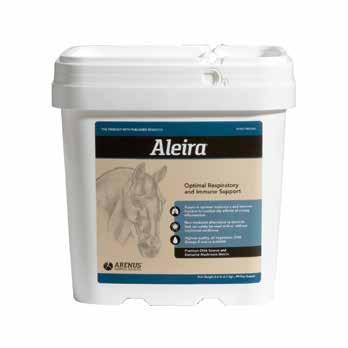

“We are so fortunate that her veterinarian recognized her signs quickly and recommended referral, as I think the quick referral made a huge difference in Lily’s outcome. Lily was an exceptionally nice donkey to work with, which may speak to how bad she felt initially. Considering her history and elevated heart rate when she got to us, we knew we needed to do some further testing quickly to find the cause of her fairly non-specific signs.”
Tests showed that Lily had elevated kidney values consistent with acute kidney injury, a common side effect of poisoning. In addition, her triglycerides were mildly elevated, which is consistent with her not eating well prior to presentation. More troubling was her level of cardiac troponin, an indicator of heart muscle damage. Lily’s initial concentration of troponin was 41 ng/mL. Since a normal level in a horse is less than 0.07 ng/mL, her care team was quite concerned, and ordered a cardiac ultrasound, which showed a mild amount of fluid buildup around her heart and mildly thickened heart muscle walls.
The definitive indicator of the origin of these issues was determined when her blood test revealed a toxic concentration of oleandrin. Lily had eaten oleander, a highly poisonous plant.
Oleander is a common ornamental plant found throughout California. All parts of the plant are toxic to both animals and people. Even the dried leaves can be very dangerous to animals which may find them palatable. Ingestion can cause diarrhea, heart arrhythmia, kidney disease and sudden death.
Lily was hospitalized for 6 days while recovering with supportive care, nutritional care and anti-arrhythmic medications. In addition, she was given activated char-
coal and IV lipid-emulsion therapy to bind the toxins in her system. A continuous ECG monitor was attached while in the hospital to monitor heart rate and rhythm. Lily responded well to treatment, and her heart and kidney values normalized by the time she was discharged. Her heart arrhythmia resolved well, but she was prescribed medication to control it at home while her heart continued to heal.
Lily was brought home where Ms. Croy continued to nurse her back to health with the help of her other donkeys. She credits their ability to calm each other and lower stress levels. Her 5 donkeys were all abused or “untouchable” before she rescued them, and they are now a bonded herd. A follow-up visit by their primary veterinarian showed normal heart rhythm, and Lily was recovering well.
Ms. Croy is quick to point out that owning donkeys is much different than owning horses.

“Donkeys are so misunderstood,” said Ms. Croy. “Everybody thinks, ‘I’d love to have a donkey— they’re just horses with long ears.’ Nothing could be further from the truth. I’ve had horses since before I was a teenager, and I had to forget everything I knew (about horses) and start over (with donkeys) because they learn differently, they respond differently—they're just not a horse. These donkeys have been an amazing journey for me.”

Lily made a full recovery, and she is back to her old self with the rest of her herd. MeV
This article originally appeared on the UC Davis website. It has been edited for style. See the original here: https://bit.ly/3oDvm4F-MEV
Images courtesy of UC Davis TOXICITY 10 Issue 4/2022 | ModernEquineVet.com
Lily after successful treatment (left) and with one of her herd mates (right). Images courtesy of UC Davis.
Tests showed that Lily had elevated kidney values.
More troubling was her level of cardiac troponin, an indicator of heart muscle damage.
nothing else like it.
For more than 30 years, Adequan® i.m. (polysulfated glycosaminoglycan) has been administered millions of times1 to treat degenerative joint disease, and with good reason. From day one, it’s been the only FDA-Approved equine PSGAG joint treatment available, and the only one proven to.2, 3
Reduce inflammation
Restore synovial joint lubrication
Repair joint cartilage
Reverse the disease cycle
When you start with it early and stay with it as needed, horses may enjoy greater mobility over a lifetime.2, 4, 5 Discover if Adequan is the right choice. Visit adequan.com/Ordering-Information to find a distributor and place an order today.
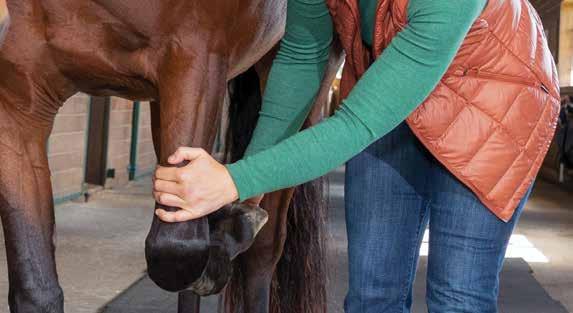
BRIEF SUMMARY: Prior to use please consult the product insert, a summary of which follows: CAUTION: Federal law restricts this drug to use by or on the order of a licensed veterinarian. INDICATIONS: Adequan® i.m. is recommended for the intramuscular treatment of non-infectious degenerative and/or traumatic joint dysfunction and associated lameness of the carpal and hock joints in horses. CONTRAINDICATIONS: There are no known contraindications to the use of intramuscular Polysulfated Glycosaminoglycan. WARNINGS: Do not use in horses intended for human consumption. Not for use in humans. Keep this and all medications out of the reach of children. PRECAUTIONS: The safe use of Adequan® i.m. in horses used for breeding purposes, during pregnancy, or in lactating mares has not been evaluated. For customer care, or to obtain product information, visit www.adequan.com. To report an adverse event please contact American Regent, Inc. at 1-888-354-4857 or email pv@americanregent.com.
Please see Full Prescribing Information at www.adequan.com
1 Data on file.
2 Adequan® i.m. Package Insert, Rev 1/19.
3 Burba DJ, Collier MA, DeBault LE, Hanson-Painton O, Thompson HC, Holder CL: In vivo kinetic study on uptake and distribution of intramuscular tritium-labeled polysulfated glycosaminoglycan in equine body fluid compartments and articular cartilage in an osteochondral defect model. J Equine Vet Sci 1993; 13: 696-703.
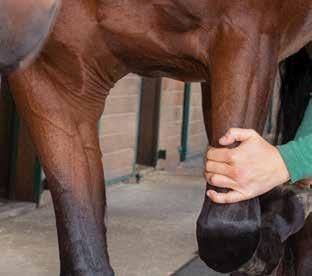
4 Kim DY, Taylor HW, Moore RM, Paulsen DB, Cho DY. Articular chondrocyte apoptosis in equine osteoarthritis. The Veterinary Journal 2003; 166: 52-57.
5 McIlwraith CW, Frisbie DD, Kawcak CE, van Weeren PR. Joint Disease in the Horse.St. Louis, MO: Elsevier, 2016; 33-48.
All trademarks are the property of American Regent, Inc.
© 2021, American Regent, Inc.
PP-AI-US-0629 05/2021
There’s
www.adequan.com
Assessing Respiratory
Disease in the Field
Many Tools Help Veterinarians Rise to the Challenge
Although assessing a respiratory issue in the field can be challenging because there are several differential diagnoses, the veterinarian has quite a few tools to help with that assessment, according to Emily Sundman, DVM, DABVP (Equine Practice), Texas Tech University, School of Veterinary Medicine.

“There are a lot of big challenges with handling respiratory disease in the horse, but 1 of the biggest is getting to that problem before it's severe, end-stage dis-
ease,” she said at the 68th Annual AAEP Convention. It is not too hard to diagnose a horse with severe asthma who is huffing and puffing, “but when they're still mildly affected or in the early stages, that could be a little harder to handle. And one of the other challenges, at least for me, is figuring out if the respiratory system is my primary problem or if I have a problem in another organ system that's giving me 1 or 2 clinical signs of the respiratory system.”
By Marie Rosenthal, MS
Shutterstock/hedgehog94
12 Issue 4/2032 | ModernEquineVet.com RESPIRATORY DISEASE
It’s just who we are.
We know horse people because we’re horse people. And like you, the love and respect we have for horses is unconditional. Everything we do is for their benefit. If we do right by the horse, we’ll never do wrong.

Copyright © 2022 Merck & Co., Inc., Rahway, NJ, USA and its affiliates. All rights reserved. US-NON-220900029 #BeUnconditional
Bryant W. Craig, DVM
RESPIRATORY DISEASE
Dr. Sundman’s Assessment
As with most equine conditions, the place to start is a good general physical exam and history before homing onto the respiratory system itself.
“That's going to help prioritize what our potential respiratory diseases are going to be since it's a long list of what can affect the adult horse,” she said.
To demonstrate her approach to a horse with respiratory disease, Dr. Sundman discussed a recent patient, an 18-year-old Gelding who had been a rope horse in Texas and was imported to Hawaii to become a pleasure horse for her client’s grandchildren. She knew the horse had pituitary pars intermedia dysfunction, which is why they called her before the horse arrived—her client had never managed a cushingoid horse before. She also knew that it had been about 2 years since the horse was vaccinated.
The trip to Hawaii is arduous, especially for an 18-year-old horse, she explained. This horse was trucked from Texas to Los Angeles, flown to Hawaii with other horses, and then rode on a barge for 24 hours until it was delivered to the island where it would be housed.
When the horse arrived, she was called because it
QUESTIONS TO ASK DURING THE EXAM
What’s the breed?
What’s the age?
What does the horse do?
When do they see the signs if they’ve occurred before?
Any recent history of acute disease?
Respiratory signs: Coughing, Nasal discharge, wheezing?
How is that horse housed?
What type of bedding?
What are its feeding practices: types of feed?
Travel history?
Any know diseases on the farm?
Vaccination status?
Allergies?
had some nasal discharge and a fever of 108° F. The owner told her that the horse was shipped with other Thoroughbreds, but no one got a good look at them when they came out of the container, and they were not being housed on the same farm.
She started with that all-important physical examination, during which, she asked about the nasal discharge—smell, color, bi- or unilateral, etc.—as well as the horse’s posture to see if it was painful. Palpating the larynx and a sinus percussion could be warranted in this case.
They found purulent, bilateral nasal discharge, but the owner said the discharge had been serous earlier in the day. And it had a mild odor, but nothing particularly offensive.
“Go ahead and conduct a rebreathing bag on a horse like this,” she suggested. “I'm outside most of the time and not always in the greatest facility. So, after ausculting the lungs, I didn't really hear much. A rebreathing bag can be helpful for assessing the lungs in the field situation.
“When I do this, I like to be careful to monitor that horse to see if I have an increase in coughing either while the bag is on or after I pull that bag off,” she said. She also times the recovery and notices whether the horse is heaving a little more than it should after the bag is removed.
Sometimes, Dr. Sundman will lunge the horse or exercise it at speed—especially if there's a complaint of an airway noise.
She also will collect samples for a CBC, chemistry panel, and run a serum amyloid A (SAA) test, which is a specific marker of an inflammatory process, depending on the case.
“Once I've completed my full respiratory evaluation, I like to start putting my case into some buckets” according to differentials and what types of diagnostic testing she might need.
And finally, she starts considering whether she needs to develop a biosecurity plan for the horse or the farm because action might be needed if the horse has an infection.
In this case, the horse developed influenza during shipping that escalated to pneumonia.
“There is a huge number of respiratory diagnostic testing that we can employ in the field. It's going to depend on what's available on your truck, what you have that day, what you're comfortable doing in the field, but also obviously on the individual case, which of these are going to be deployed and appropriate and within the budget,” Dr. Sundman said.
She called the state veterinarian who inspected the horses in Honolulu, and found several of its fel-
14 Issue 4/2032 | ModernEquineVet.com
low travelers reported the same signs.
“We have a bunch of friends who came off the barge feeling kind of crummy,” she said, which to her points to viral pathogens coming up to the top of the list. At this point, consider doing a nasal swab for a respiratory PCR panel, especially if the horse is still febrile. It can be submitted later if needed, but at least you have it.
She also would consider doing thoracic ultrasonography, which she called a “fantastic diagnostic tool to take out with you on the truck” because it can help visualize infectious and non-infectious lower airway problems.
“It can give you direct information at the time of that visit. You can do something great in front of the owner, and it provides an opportunity for serial evaluations” if the horse has a chronic condition.
It’s important to complete the full bilateral examination of all lung fields because so little of the equine lung can be penetrated, she recommended.
In this case, she found consolidation in the left cranial ventral quadrant of the lung with a moderate amount of fluid.
Her next tool in the toolbox would be to do either a transtracheal wash and or bronchoalveolar lavage (BAL). They can be done with or without endoscopy, depending on the comfort of the veterinarian.
“There's not really a huge reason to choose one over the other. So, what you're comfortable with, what you have experience with. I would say “in my hands,” because I'm not working in a hospital and I don't always
have the greatest facilities to work out of—or all the equipment that I would need to support—that I tend to do these non-endoscopically,” she said.
Other times, you might want to include respiratory endoscopy in the field as part of your work up, she said, because it is a versatile tool.
“When I do a respiratory endoscopy, I like to have a plan based on my physical exam and my respiratory exam findings,” she said, and make sure you stick to the plan. “I try to do the exam in the order of anatomy [I will encounter]. I break these up into my upper airway exams, my lower airway exams and finally my guttural pouch exam,” she said.
“We did go ahead and do the endoscopy following the trans-tracheal wash to rule out strangles given the unknown history of this horse and where it was coming from. When we went on in, we were able to see findings that were consistent with everything we'd done so far, which is always the ideal world with respiratory endoscopy.
“I had this kind of gnarly purulent material at my larynx as I started,” she said, which fit with the transtracheal wash findings, and the guttural pouches were clear.
“I think the respiratory system has some of the best toolbox options for the field, but they really depend on your comfort level, what equipment you have, and how you want to proceed with those. But it really is an opportunity to do something without having to refer in to get some answers,” Dr. Sundman said. MeV
Study Reveals Opportunities to Increase Productivity
IDEXX Laboratories, Inc., announced a first-of-itskind empirical study aimed at addressing veterinary practice capacity.
Finding the Time: Empowering Veterinary Teams to Get the Most Out of Every Day, IDEXX introduces the veterinary Practice Productivity Index, a data-driven framework and collection of guides for transforming practice productivity across the dimensions of workflow, technology and culture. The study reveals opportunities to find up to 2,000 hours per year—the equivalent of adding one full-time veterinarian. The findings are based on 786 survey participants, in-depth clinical observations, financial evaluations, and extensive practice-level data.
“Veterinary professionals operate in an entirely new landscape compared to a few years ago,” said Jay Mazelsky, IDEXX president and CEO. “Veterinary practices have asked us for strategies and solutions to address the challenges they’re facing. A key insight from the study is that small steps can help them find more hours in the
day, and when improvements are implemented strategically, they can have a significant impact.”
Finding the Time sheds light on staffing challenges throughout the veterinary industry while providing strategies for creating additional capacity and ultimately supporting a happier, healthier veterinary team.
• In the workflow category, 82% of study respondents indicated that they are trying to hire at least one staff member and are experiencing difficulties filling those positions.
• Within the technology dimension, 85% of respondents noted that their practice’s software applications and platforms do not integrate well with their practice information management system (PIMS), resulting in inefficiencies.
• The study also reflects how a practice’s culture, including its approach to talent development, impacts a team’s productivity. MeV For more information: www.idexx.com/FindingTime.
ModernEquineVet.com | Issue 4/2023 15
Treating Anhidrosis with Acupuncture
By Karen Chapman, LVT
Eatin on the Run was an 8-year-old Quarterhorse gelding competing in the sport of cutting when his owner first noticed he was not sweating after intense exercise. Many various treatments were used including several electrolyte supplements, and the anecdotal can of dark beer once daily. Nothing cured the problem, although the horse, of course, fared better in the winter months and at air-conditioned indoor shows. If the shows were long enough, and he was housed in an air-conditioned stall, he would start sweating near the end of his stay. This supports the theory that often moving the horse to a colder, less humid environment will eventually restore its ability to sweat.
As the horse aged and retired, the pattern became a week or 2 of pronounced difficulty in thermoregulation in early summer followed by the ability to remain comfortable given a pond and shady pasture. One year, Run did require a 3-day stay in an airconditioned medical facility though. At this point, the owner met a veterinarian trained in acupuncture who felt he might be able to help.
By this time, Run was 19 and fully retired except for pasture riding. On June 8, 2019, upon presentation, Run was slightly depressed, tongue dry and tacky, dark red and with a thick yellow coating. He was tachypneic (42 breaths/min.) with rapid full



pulses bilaterally (72 beats/min.) This was a June afternoon after standing in a pasture all day.
His TCVM (Traditional Chinese Veterinary Medicine) diagnosis was summer heat with lung Qi deficiency. Dry needles were placed bilaterally at BL-13 the back-shu association point for lung, BL-22 the back-shu association point for triple heater (TH), LI-4, GV-14, LI-11 to clear heat and open the sweat pores. Hemoacupuncture to clear summer heat was performed with 25 ga., 5/8" hypodermic needles at Tia-yang (GB-1) and TH-1, LU-11, SI-1 and HT-9 bilaterally, Wei-jian and Er-jian. Hemoacupuncture was also performed bilaterally at Xiong-tang using 22 ga., 1.5" hypodermic needles. All needles were left in place for approximately 20 minutes. One hour after treatment, the horse had begun to sweat in patchy areas. Watermelon rind (not the fruit) was also recommended to begin feeding whenever possible as this is a “cooling food.”
One week later, June 16th, Run was treated again. This time upon presentation, the tongue remained dark red but was moist. Pulses were still rapid and forceful bilaterally (68 beats/min.). Dry needles were placed at Bai-hui, LI-4, LI-11, HT-7, BL-13, BL-22, BL-40, GV-14, and Feishu. Hemoacupuncture was repeated at Er-jian, Wei-jian, Tai-yang, Xiong-tang, TH-1, LU-11, SI-1 and HT-9.
When examined on June 27, the tongue remained
16 Issue 4/2032 | ModernEquineVet.com TECHNICIAN UPDATE
Images courtesy of Karen Chapman, LVT
This horse suffered from anhidrosis, which means, it could not regulate it's body temperature by sweating.
Fig. 1
Fig. 2
dark red and moist, but vitals had normalized to Temp: 99.4˚ F, Pulse: 44 beats/min, and Resp: 24 breaths/min. Run was much more comfortable and he was treated like that of June 16, but with BL-10 substituted for Bai-hui, for its sedative effects.
Upon examination on July 16th, the tongue was dark pink and moist, and pulses were 48 beats/min. and no longer forceful. By this time of summer, flies were out in full force and Run’s fly allergy was active. Hemoacupuncture points treated on previous visits for anhidrosis were repeated as well as dry needles at LI-4, Fei-shu, HT-7, BL-13, BL-22, and KID-7. In addition, BL-10, BL-12, Feimen (SI-14), and GB-20 were treated to help clear wind and stop itching.
By Aug 9, after a long, hot summer, Run appeared comfortable, but his tongue was dark pink and tacky, and his pulses were again forceful. His sweat pattern was limited to his head and neck (Figure 1) Dry needles were placed at BL-10, BL-12, BL-13, BL-22, GB-20, LI-4 and SI-14. Hemoacupuncture was performed at Wie-jian, Er-jian, Tai-yang, TH-1, and Xiong-tang. He remained comfortable over the next year.
The following year, Run was moved to an 80-acre pasture and was unable to be observed daily. As a preventative, Run was examined and treated for anhidrosis to prepare him for the summer months. He appeared comfortable with patchy sweating behind his ears and elbows like that of his pasture mate. His tongue was moist and pink, and his pulses and body temperature were normal. Dry needles were placed at BL-10, BL-13, BL-40, LI-4 and hemoacupuncture was performed at Wei-jian and Er-jian. One week later, he was found to be in a full body sweat for the first time in more than a decade. (Figure 2)
Results
This case report shows the effectiveness of acupuncture therapy for anhidrosis management. Run continues to be treated every spring/early summer, usually with two acupuncture sessions which keep him comfortable throughout the summer. His exercise is minimal, and any riding is done during the cooler parts of the day and always followed with a good water soaking to help him cool off. He can produce enough sweat to keep him cool and is fortunate to
For more information:
Teaching Points
Anhidrosis is a word that sparks dread in the hearts of horse owners in many parts of the country. In laymen terms, it means the horse is a “non-sweater,” and in the Texas summers where the heat and high humidity can easily reach 110˚ F for extended periods, this can be a serious problem. Not only can horses’ show careers get put on hold, but their lives can easily be in danger from heat stroke. Horses lose 65% to 70% of their body heat through the evaporation of sweat so when the body is no longer producing this, body temperatures can soar dangerously high, resulting in hyperthermia and death.
The cause of anhidrosis is not fully understood but the condition is often listed with symptoms of PPID in horses and associated with a metabolic imbalance. This could possibly be because of overstimulation of the horse’s sweat glands by stress hormones. The disease’s onset can be acute or gradual but in the case of this PPID-positive horse, signs showed up slowly and increased with age.
have breezes and large oak trees to keep him shaded. Anhidrosis is not cured but can only be managed and acupuncture has enabled Run to live a much more comfortable life. Continual treatments are to be expected until this horse relocates to a cooler climate. If you have a horse with anhidrosis, prepare to change your performance expectations and make a treatment plan, which might include acupuncture, to help when the temperatures heat up! MeV
About the Author
I work with research animals at Texas A&M’s Comparative Medicine Program. While I no longer get to treat horses, I stay true to my equine roots and am currently serving as the President of the Association of Equine Veterinary Technicians and Assistants. I enjoy the equine community, supporting fellow equine technicians and helping to provide a better quality of care to the animals I love. I currently own a retired cutting horse and still enjoy going for rides in the country.
Brinsko, Steven P. Acupuncture Treatment of Anhidrosis in a Quarter Horse Gelding. TCVM Class: Fall 2016
Mallicote, Martha. Anhidrosis: Help – My Horse Doesn’t Sweat! University of Florida Large Animal Hospital. https://largeanimal.vethospitals.ufl.edu/equine-anhidrosis
Anhidrosis in Horses. Hagyard Equine Medical Institute. https://www.hagyard.com/anhidrosis-in-horses#
ModernEquineVet.com | Issue 4/2023 17
Shutterstock/nelelena
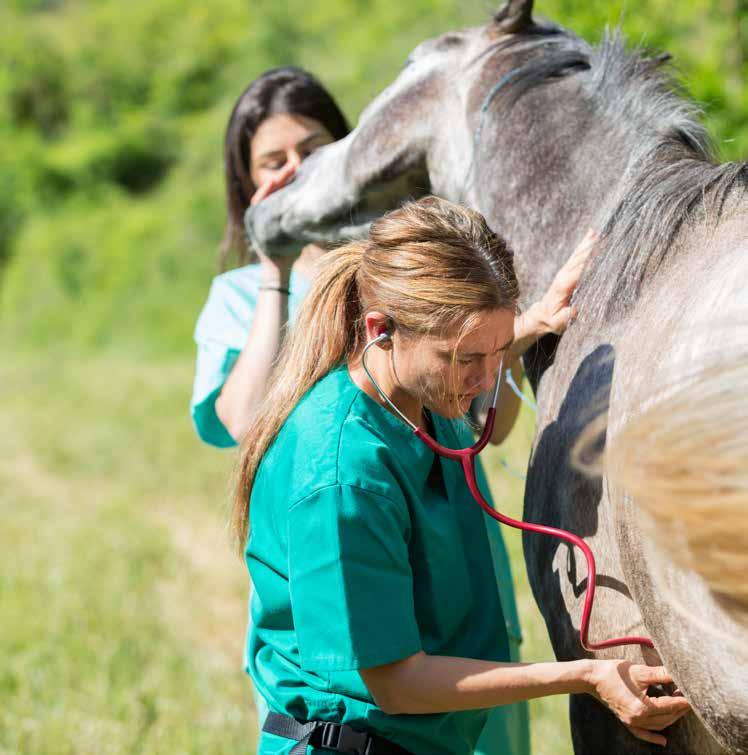
Reach your veterinarians wherever they are, whenever they want. FOR ADVERTISING RATES AND INFORMATION, EMAIL For advertising rates and information, email ModernEquineVet@gmail.com Equine Vet The Modern














































